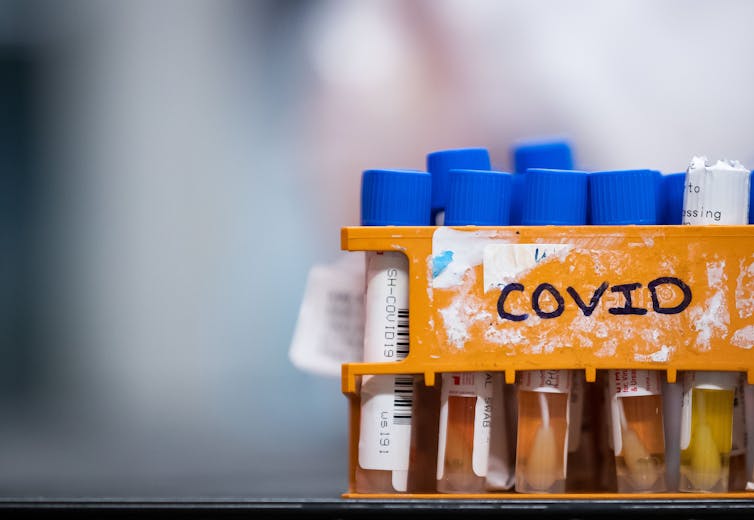 |
| Specimens await testing for COVID-19 at LifeLabs in Surrey, B.C. (THE CANADIAN PRESS/Darryl Dyck) |
As the coronavirus pandemic continues its spread, it has infected more than half a million people and killed tens of thousands on nearly every continent. With offices shut down, people staying at home and hospitals bracing for an influx of patients, many people are unsure of what’s safe and what’s not.
Here are answers to some of the common questions people keep asking about coronavirus.
Can people without symptoms spread the virus?
The short answer appears to be yes, some infected individuals who have not shown symptoms can spread the virus and this remains an issue of great concern. This is why social or physical distancing is considered to be so critical to slowing or reducing the transmission of the virus.Modelling studies in China and Japan, and testing of those on the Diamond Princess cruise ship suggest that a small number of people who are infected do not develop symptoms. We don’t know much about how infectious these asymptomatic individuals might be, that is, how likely they are to spread the disease.
Most studies done to date, often with small numbers of people, show that a person sheds more virus with the initial onset of symptoms — when they first start coughing (or sneezing), which can send the virus into the air in a fine spray. But a recent study in the New England Journal of Medicine documented that some people with no or very mild symptoms can shed significant amount of virus. Children, who may not experience any symptoms or only very mild symptoms, may also be able to spread the infection.
One important caveat here is that symptoms are subjective. One may feel a bit off but give it little attention and not report it to a health-care provider or researcher. So it may be difficult to conclude in these studies that someone recorded as asymptomatic is truly so. Cultural factors may affect how and when people report symptoms or seek care.
How long does the virus stay on surfaces?
Can the coronavirus persist on the mail, produce at the supermarket, gas pumps and so on? A study published in the New England Journal of Medicine suggests the virus can survive for up to two or three days on some surfaces, particularly hard plastics and steel. It is also easier for people to pick up the virus if they touch these surfaces. |
| Stay home if you can. But if you use a shopping cart, wipe it down with disinfecting solution and clean your hands afterwards. (Pexels) |
The most important issue here is to avoid touching things that many other people have touched recently — elevator buttons, grocery carts, door knobs and hand rails — or to wash one’s hands right away or use an effective hand sanitizing solution such as Purell.
Many grocery stores now provide wash stations and disinfecting solutions for wiping down carts. Use them!
The evidence at hand indicates that the virus degrades rapidly on porous surfaces such as cloth, paper and cardboard. So the risks for infection from handling paper and cardboard (mail and packages) may be low, but the same rules apply — after handling, wash your hands thoroughly.
It is important to remember that the main route of transmission will be directly from one person to another via coughing or sneezing.
Which chemicals kill the virus?
Any soap or detergent will destroy the virus, as will solutions of bleach and water, Clorox disinfectant wipes, Lysol brand cleaners, Purell, etc.Here’s a full list.
 |
| Disinfect surfaces to reduce the spread of coronavirus. (Shutterstock) |
What does ‘stay at home’ mean?
Authorities use different terms to describe measures to keep people away from one another to avoid spreading the virus. You may hear “stay at home,” “shelter in place,” “self-isolation” and “quarantine.” All of them involve social or physical distancing to reduce rates of transmission.Technically speaking, “quarantine” restricts the movement of of people who may have been exposed to the virus but do not have symptoms. The term comes from the plague era in Europe where ships were not allowed to dock for 40 days to demonstrate that their crews were free from the disease. Quarantine is most often used to describe the closure or isolation of geographic locales where a disease is spreading, as was the case in Wuhan, China, although the restrictions are being relaxed.
Perhaps because quarantine may be seen as invoking the coercive powers of the state or stigmatizing those living in affected locales, many public health officials avoid its use.
Canada, for example, focuses mainly on encouraging voluntary measures, distinguishing between “self-monitoring,” where one may have been exposed to the virus (perhaps someone at work felt ill) and is asked to monitor oneself for symptoms, and “self-isolation,” where one has no symptoms, but may have been exposed from travel outside their place of residence or from close contact with someone diagnosed with COVID-19.
“Isolation” is for people who actually have the virus or suspect that they may be infected. Those with symptoms will be asked to isolate themselves in their homes, staying away from others as much as possible.
“Shelter in place” simply means asking people to stay at home as much as possible. “Stay at home” requests are similar, but may be backed by more formal requirements, such as in Italy, where people may not leave their homes except to go out for essentials, such as food and medicine. Stay-at-home orders are usually accompanied by closures of restaurants, bars, gyms, cancelling of public events, etc., and may be backed by legal sanctions and fines.
Can COVID-19 cause long-term lung damage?
At this early stage of the pandemic there is no evidence to show that permanent or long-term lung damage is a common consequence of infection. A report from Hong Kong suggests short-term declines in lung function among those recovering from COVID-19. |
| An electron microscope image for the SARS-CoV-2 virus (in orange) emerging from a cell (grey) that had been cultured in the lab. (NIAID-RML) |
However, these reports describe currently ill or newly recovered victims of the disease. It is still too soon to know whether the damage caused by the infection is permanent or long-term.
Can ibuprofen make COVID-19 worse?
This idea circulated on the internet for a few days, proposed initially by the French health minister, and based on some earlier studies of the impact of ibuprofen on respiratory infections. Initially the World Health Organization repeated this warning, but after examining the evidence it reversed its position, declaring that based on documented clinical experiences with patients, there is no evidence that ibuprofen makes the infection worse.Does blood type matter?
A study of COVID-19 patients in Wuhan and Shenzhen, China who contracted COVID-19 suggested a higher proportion of infections among those who had blood type A. But the differences identified were relatively small and at this point would not have any impact on how we manage either the spread or treatment of the disease. But it is an interesting finding that requires further study.About Today's Contributor:
Craig Janes, Professor and Director, School of Public Health and Health Systems, University of Waterloo
This article is republished from The Conversation under a Creative Commons license.

















